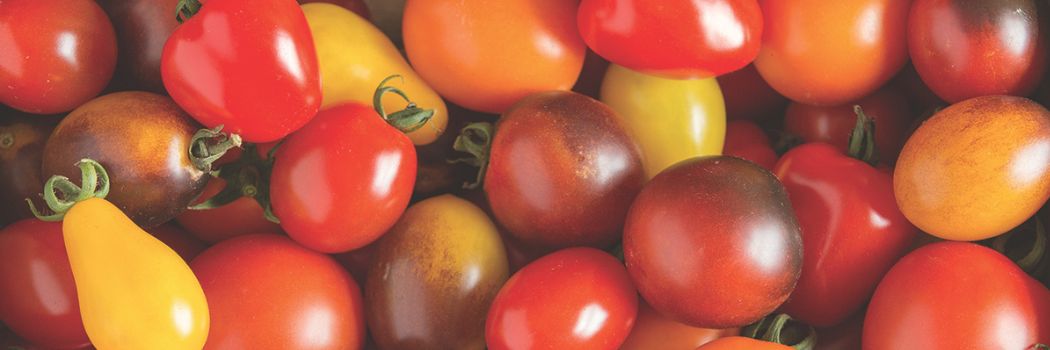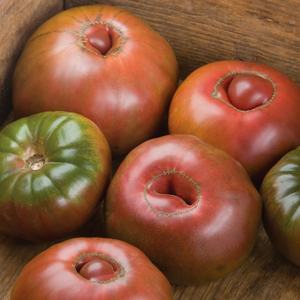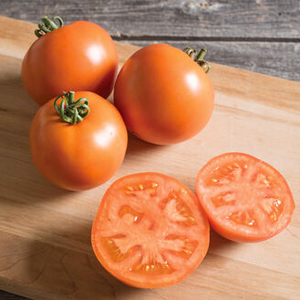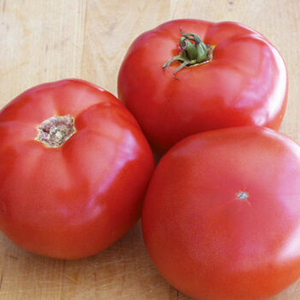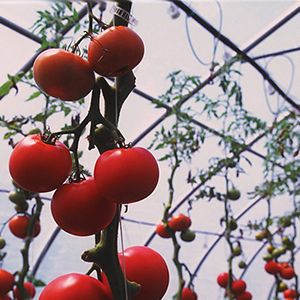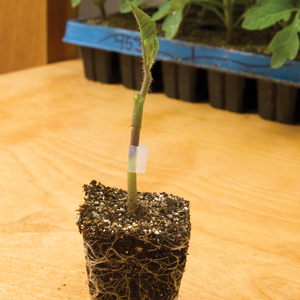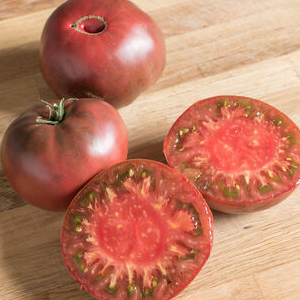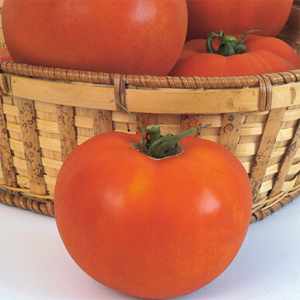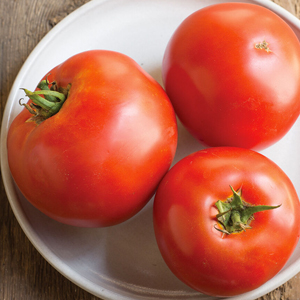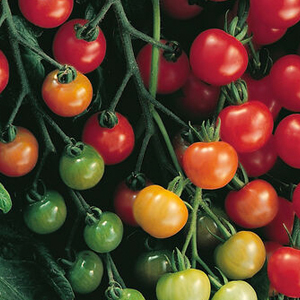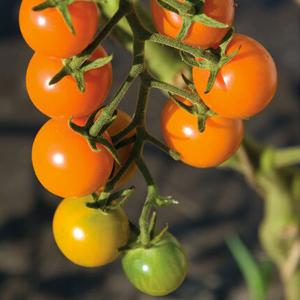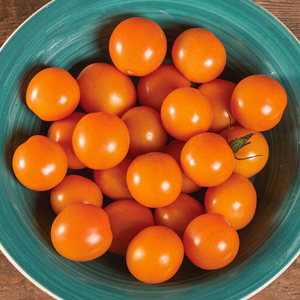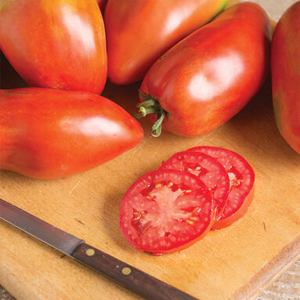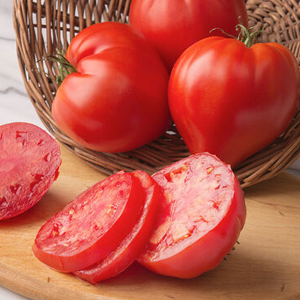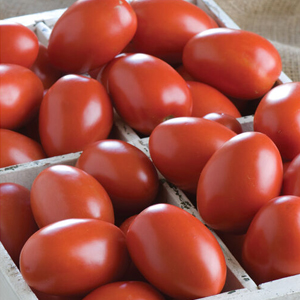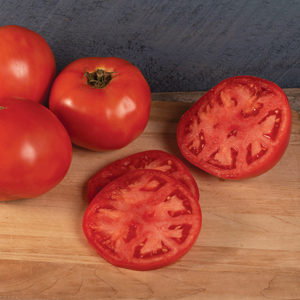- 10 Tips for Growing Heirloom Tomatoes
- Webinar Slide Deck | Tomatoes: 10 Unsung Heroes | 34-pp PDF
- Common Tomato Pests, Diseases & Physiological Disorders | An Overview of Biotic & Abiotic Problems
- French Heritage Tomato Varieties | The Best of the Old World Marries the New
- Grafted Tomato Plants | Key Growing Information
- Greenhouse Tomatoes | Key Growing Information
- Grow a Rainbow Mix of Cherry Tomatoes
- 'Maxifort' Rootstock Tomato Germination | Tech Sheet (PDF)
- Open-Pollinated Revival Project: 3 Improved OP Heirloom & Heritage Tomatoes
- Rootstock Tomatoes | Key Growing Information
- Determinate Tomato Varieties | Comparison Chart (PDF)
- Greenhouse Tomato Varieties | Comparison Chart (PDF)
- Greenhouse Tomato Pruning & String Trellising | Tech Sheet (PDF)
- Heirloom Tomato Varieties | Comparison Chart (PDF)
- Indeterminate Tomato Varieties | Comparison Chart (PDF)
- Tomatoes | Key Growing Information
- Paste, Plum & Roma Tomato Varieties | Comparison Chart (PDF)
- Basket-weave Trellising Instructions for Tomato & Pepper Plants | Tech Sheet (PDF)
- Side-Grafting Tomatoes | Advantages, Materials, Technique | Tech Sheet (PDF)
- Top-Grafting Tomatoes | Advantages, Materials, Technique | Tech Sheet (PDF)
- Tomato Production Challenges & Issues | Tech Sheet (PDF)
- Video: Tomato Top-Grafting Demo: Splice Grafting & Cleft Grafting • Materials & Technique
- Video: An Intro to the Fundamentals of Tomato Grafting Success | Johnny's Webinar Series
- Video: How to Grow Cherry Tomatoes • From Seed to Harvest
- Video: Artisan Tomatoes™ | from Johnny's Selected Seeds
- Video: How to Prune Greenhouse Tomatoes
- Video: 'Cherry Bomb' | JSS-Bred Organic Cherry x Grape Tomato from Johnny's
- Video: 'Clementine' | The Tangerine-Colored, Organic Cocktail Tomato from Johnny's Breeding Team
- Video: Tomatoes: 10 Unsung Heroes | Johnny's Webinar Series
- Video: How to Identify Late Blight on Tomatoes
- Video: How to Manage Late Blight on Tomatoes (Phytophthora infestans)
- Video: How We Process Our 'Washington Cherry' Tomato Seed
- Video: How to Prune Tomatoes
- Video: How to Graft Greenhouse Tomatoes
- Tomatoes: 10 Unsung Heroes | Johnny's Educational Webinar Resources
- Video: Growing Tomatoes in Containers with Niki Jabbour & Johnny's
- Late-Summer Recipe Preview with Farmer-Chef Frank Giglio | Three Lily Farm, Thorndike, Maine
- Video: Choosing & Growing Paste Tomatoes for Sauce-Making • with Niki Jabbour
- Video: 'Hot Streak' : The Vibrant New Striped Tomato | Exclusively from Johnny's
- Video: High-Value Crops & Varieties for Your Garden • Tutorial with Niki Jabbour
- Tomato Variety Trends: How Breeding Influences Your Seed Selection | Johnny's Educational Webinar Resources
- Video: 'Mochi' : The Gumdrop-like Cherry Tomato | Exclusively from Johnny's
- Video: Tomato Pruning 101 • Tutorial with Niki Jabbour
- Tomato Innovation: Breeding & Trialing for Your Finest Harvest
- Fundamentals of Tomato Grafting | Johnny's Educational Webinar Resources
- Webinar Slide Deck | Fundamentals of Tomato Grafting | 15-pp PDF
- Top-10 Field Tomatoes to Try in Your High Tunnel
- Tomato Innovation: Breeding & Trialing for Your Finest Harvest
- Webinar Slide Deck | Tomato Variety Trends: How Breeding Influences Your Seed Selection | 29-pp PDF
- Trellising & Crop Support Systems for Tomatoes | Stake & Basketweave, Stake & Hanging String/Wire, Lower & Lean
- Video: Tomato Variety Trends: How Breeding Influences Your Seed Selection | Johnny's Webinar Series
- 3 Ways to Choose the Best Tomato Varieties | Johnny's Selected Seeds
3 Ways to Choose the Best Tomato Varieties For Your Needs
3 Key Questions
Every year at Johnny's we evaluate thousands of tomatoes, with just one end-goal: bettering your tomato-growing success. From the many, we choose only the best. Because of the tremendous diversity in tomatoes, though, and wide variation in grower needs and preferences, our line of tomatoes still numbers well over a hundred options. From these promising candidates, how do you as a grower narrow the field down to just the right ones for you? To help simplify your decision-making process, start with these 3 questions:
- Habit: Which vegetative growth habit best suits your needs? Indeterminate (tall and viney) OR determinate (bushy)?
- Location: Where will you grow your tomatoes? Outdoors (unprotected setting) OR indoors (protected setting)?
- Fruit: Which fruit characteristics are of greatest importance to you? Flavor, aroma, color, texture, shape, size, earliness, yield, culinary use, or …
1. Habit • Choose by vegetative growth habit
The first consideration when choosing a tomato relates to its plant habit. There are two major types of vegetative growth habits in tomatoes, plus some other, less clearly-defined subtypes with in-between features, including semi-determinates and dwarves.)
Indeterminate.
These are vining types that continue to grow new leaves, shoots, and flowers for an indefinite time period (until frost or some other factor causes them to die).- An indeterminate growth habit requires more elaborate trellising methods than determinates to support the larger plants, and more labor to sucker and prune them across their lifespan.
- Indeterminate varieties have a higher ratio of leaves-to-fruit-clusters ( > 3:1) than determinate (bush) types ( < 2:1). As a direct result, they tend to have better flavor.
- The harvest window for indeterminates is lengthier than that of determinates.
- You can compare key features using our Indeterminate Tomato Comparison Chart.
Determinate.
These are bush-type tomatoes that grow to a certain size, then divert their major energy stores away from vegetative structures toward flower and fruit development and ripening.- Determinates have a better ratio of labor-to-production potential, meaning they require less hands-on work than indeterminates do.
- Determinate types are easier to contain because their vegetative growth is less sprawling and more concentrated into a shorter time span.
- Fruits of determinate tomatoes ripen over a limited period of time, allowing for one or two relatively concentrated main harvests.
- You can compare key features using our Determinate Tomato Comparison Chart.
Semi-Determinate.
Semi-determinate types have habits that fall somewhere in-between the determinate and indeterminate types.- Sometimes referred to as "vigorous determinates," they are larger than the compact determinate types yet produce fewer suckers than indeterminate types.
- Because they are shorter than indeterminates but with longer vines than determinates, we recommend stake-&-basketweave trellising, using poles at least 3 feet in height and basketweave trellising.
- Examples of popular semi-determinate tomatoes include 'BHN 589', 'Celebrity Plus', and 'Celebrity Plus'.
Dwarf.
Most dwarf tomatoes are simply diminutive forms of either determinate or indeterminates with tidy habits that work well in small spaces. They are often suitable for growing in containers.- A couple prime examples of the patio-tomato type include 'Sunrise Sauce,' a sweet, low-maintenance orange paste tomato, and 'Tidy Treats,' a tasty, high-yielding red cherry.
To learn more about 3 systems for trellising tomatoes in the field or protected culture, including basic instructions for set-up, see Trellising & Crop Support Systems for Tomatoes: Stake-&-Basketweave, Stake-&-Hanging-String/Wire, Lower-&-Lean.
2. Location • Choose by where you grow your tomatoes
The second consideration is where your plants will be grown — outside in the field or within an enclosed environment, such as a heated greenhouse or unheated hoophouse.
Protected Culture.
If you are growing tomatoes within any type of protective structure, it is worthwhile to choose from varieties bred specifically for that purpose. Here's why.- Greenhouse. Generally, the warmth and humidity that promote rapid plant growth in a heated greenhouse can also be favorable to certain fungi, bacteria, and other plant pathogens. More specifically, conditions within will depend upon the extent of technology you've applied to your protected-culture setting, whether it be control of temperature, light, air circulation, or otherwise. To offset risks, there are varieties available that have been specifically bred for, selected, and trialed within a greenhouse setting. Because seeds for these Greenhouse Performers are more costly to produce, however, they have a higher price point than those that are not.
To learn more about what to look for in a greenhouse tomato and why, see the tomato section of our article on Recommended Varieties for the Greenhouse. You can also compare key features using our Greenhouse Tomato Comparison Chart. - Hoophouse or High Tunnel. This type of production falls in-between that of a greenhouse and that of the open field. Conditions within this setting can be more variable than in a greenhouse, but again relate to your latitude, local climatic conditions, the openness of the tunnel, time of year, and whether or not you apply technology to your set-up.
Our tomato trialing team has compiled a list of the Top-15 Tomatoes for Hoophouse & High Tunnel Production expressly to guide you in choosing well for this setting.
Outdoor Culture.
If you are growing outdoors — whether it be in a field, your backyard garden, a raised bed, containers, balcony, patio, or rooftop — you will want to check the days to maturity (DTM) of the variety you choose. Calculate how soon to start your seedlings indoors in the spring in relation to the average length of your growing season and the DTM, to predict whether the variety will have enough time to grow, reach maturity, and fruit for you.In any outdoor system it is also important to choose tomato varieties that are resistant to the disease pressures known to affect tomatoes in your area.
Protected, unprotected, or somewhere in the middle, be sure to check for symbols that designate growth habit and other key information while browsing Johnny's tomato varieties. You will find information on the product page that indicates their days to maturity, disease resistances, germination times, cultivation, harvesting, processing, and other useful features.
3. Fruit • Choose by the qualities you most desire
The one thing we all desire in a tomato — flavor — seems to be the quality most elusive in the standard American grocery-store tomato. It's long been common for producers, shippers, grocers, and even restaurants to sacrifice flavor for sturdiness that can withstand the vicissitudes of disease, rough handling, and a protracted field-to-plate journey. Fortunately, there's been a reversal of the trend in more recent years, resulting in better alternatives for most consumers. Nevertheless, the perfect home-grown or marketstand tomato remains a prized commodity.
Preferences in tomato color, flavor, and texture are highly subjective, so pleasing everyone's palate and meeting their aesthetic ideals can be quite a challenge. We will get further into flavor and texture below, but here are some general observations to serve as a starting point.
Helpful Rules Of Thumb
- Color. Yellow and orange tomatoes tend to be less acidic and milder-tasting than red and pink tomatoes.
- Texture. Some people prefer the pulpier texture more closely associated with heirloom tomatoes, while others seek the firm texture commonly associated with greenhouse and determinate types.
- Yield. Because yield is critical to most growers, Johnny's evaluates the marketable versus unmarketable yields of varieties in our tomato line to determine the best overall combination of yield, flavor, and texture.
Even as we place the premium on flavor, we are scrutinizing a host of additional factors that play into tomato perfection (or failure): days to maturity, habit, size, shape, color, vigor, pest and disease resistance, yield, cracking, blemishes, and shelf life, among many others. Our selection criteria are numerous, and our trialing process is complex because it is designed to make your tomato choices easier and your growing more successful.
Online Product Filters
For most gardeners and growers, the above 3 questions drive most decisions regarding tomatoes. But there will be other factors that matter to you, or to your customers, to a certain degree. You may want to grow exclusively organic tomatoes or only open-pollinated tomatoes, for example. We encourage you to use the series of filters built into our tomato listing to narrow the field to what's most important.
If you're still not sure what you are looking for, read on for our recommendations.
Which Is the Best Tomato? Our Top-5 Recommendations
Looking for the best tomato variety in a particular category? As noted above, we designed a range of filters and built them into our tomato category listings to help make it easier for you to sort through the varieties to find the ones that match your unique methods, needs, and preferences. If you're just starting out and would like some direction, though, these are a few of our own favorites for flavor, sweetness, meatiness, disease resistance, and for making that simplest validation of summer-garden success, the tomato sandwich. Although the answers aren't quick ones, we hope you'll enjoy our recommendations.
1 • Which tomatoes have the best flavor?
A lot goes into the makeup of tomato flavor — in fact, one reason it's so difficult to breed better-tasting new varieties of tomatoes is because of the biochemical and genetic complexity of flavor. It is greater than the sum of its parts: a whole matrix of sugars and acids, plus over 400 different volatile compounds (at last count), all working in concert with more subjective qualities like "mouth feel" and visual appearance.
To add layers to that complexity, flavor can vary considerably by where the plant was grown, as well as how and when — factors that influence atmospheric, light, and mineral exposure. And while it's beyond the scope of this article to fully discuss the tomato's organoleptic qualities (the taste and aroma properties of a food), it can be said that flavor will vary between plants in the same variety and even between fruits from the same plant. No wonder that flavor, like taste, is largely subjective.
Yet complexity never stopped anyone from playing favorites. For growers who love them, it may be one of the most beautiful things about tomatoes. For a trio of varieties celebrated for their rich, balanced flavor, try:
- 'Cherokee Purple': Organic heirloom with famously rich flavor and texture.
- 'Celebrity': Semideterminate long popular for its flavor and adaptability.
- 'Big Beef': Beefsteak with a nice combination of size, taste, and earliness.
2 • What is the sweetest tomato to grow?
To many people's palates, the more sugary the tomato, the higher its likeability. It's not just Westeners who are sugar-crazy, though. In many traditional Chinese night markets, you can sit down to a plate piled high with fresh, thinly sliced tomatoes, heaped higher with sugar. Candy-coated cherry-tomato kebabs are a more recent, portable favorite in China, the nation where the most tomatoes are grown (by far, according to data from the Food & Agriculture Organization Corporate Statistical Database).
Along with containing good amounts of the principal sugars fructose and glucose, tomatoes share another feature in common with many fruiting crops: an increased percentage of sugar will come at the price of smaller fruit. What that means is that most of the sweetest tomatoes are small tomatoes. Luckily, most people don't mind minimally smaller fruits, provided they taste good. The inverse relationship between sugar content and size is a truism in nature that holds well for some of our most popular sweet tomato varieties:
- 'Supersweet 100': One of our top-selling red cherry varieties, with a name that says it all.
- 'Sun Gold': Delectably sweet and fruity orange cherry that we introduced to the U.S. in 1991.
- 'Citrine': Johnny's-bred tangerine cherry with exceptionally sweet flavor. Our classical breeding team worked for years to develop this solution to Sungold's unfortunate tendency to crack.
3 • Which are the meatiest tomatoes?
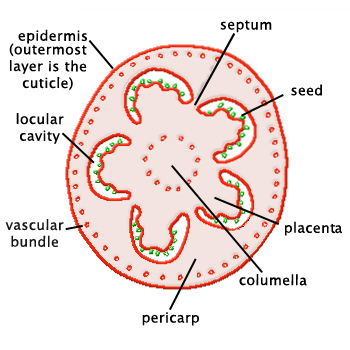
This is a good question, because nowadays it seems more the exception than the norm to see a tomato variety not being described as "meaty." Understandably, this can make it difficult for growers to figure out which ones are the meatiest. Measuring meatiness is not an exact science, either. Let's take a closer look at what it is that makes up a tomato's texture (hint… it's not meat).
Before we look at the anatomy of a tomato, it helps to define some terms. Botanically, the tomato is a fruit. Most tomato varieties produce fruits with either 4 or 5 seed cavities, known as locules, as shown in the schematic, or 2 locules, as with most cherry tomatoes.
The type of fruit that tomatoes produce is known as a classic berry, and its fleshiness — or meatiness — results from the tissue within known as the pericarp and the placental tissue surrounding the locules.
As the tomato berry ripens, it undergoes all kinds of metabolic changes influenced by genetics and environment both. Enzymes begin to digest the cell walls, softening the pulp, and the placental tissue around the ovules starts to become gelatinous. Once the fruit reaches maturity, it dehisces, or breaks away from its pedicel, or stem.
When you go to slice and bite into the tomato fruit, the texture you experience at that very moment is a reflection not only of the genetics particular to the variety and the individual plant's growing environment. It also relates to how much time has elapsed between the fruit's peak maturity — if it makes it that far — and consumption — plus everything that may have happened to it in the mean time.
To taste-testers, that textural quality is what is known as mouth feel. As in all things tomato, there is no shortage of opinions about what constitutes the best mouth feel, so establishing data points for "best meatiness" can be a tough call. But in more good news for tomato-tasters, inroads are being made in an obscure field known as acoustic tribology. In their bid to quantify mouth feel, researchers assert, strangely enough, that the way in which we perceive a food's texture relates to how the food sounds on our tongues. Or, as more aptly headlined by Smithsonian Magazine, To Measure the Taste of Food, Listen to Your Taste Buds.
Since that's more than mouthful on mouth feel, let's cut to where we would pin the ribbons for meatiest.
- Heirloom / Open-Pollinated (OP): 'Blue Beech' is one of our best and newest meaty types. Not only is 'Blue Beech' meaty, with so much that's good to say about it, we devoted an article to this heirloom variety and two of its open-pollinated amicas. Learn more about their history, qualities, and adaptability to short seasons and low-input environments, in Johnny's Open-Pollinated Revival Project: 3 Resurrected Heirloom & Heritage Tomato Varieties.
- Greenhouse: The prize here for meatiest goes to our French Heritage hylooms. Bred in Provence, these varieties marry the best of the Old World with the New, providing heirloom-like eating in a disease-resistant package. Similar to many a hothouse flower, these varieties can take a little bit of extra care — growing best with 14 hours of daylight — but we think they're worth it. For the nonpareil, try the French heritage oxheart 'Cauralina' — it delivers meatiness in spades.
4 • Which are the best disease-resistant tomatoes?
As the disease pressures you will face depend upon where you grow, so, too, will the answer to this question. From the macro down to the micro level, indoors, outdoors, and in-between, environment is one of the three prongs in the host-disease-environment triangle.
To help acquaint tomato growers with the most common disease-related issues, we compiled an overview of Common Tomato Pests, Diseases & Physiological Disorders. It also touches on a few of the developmental mishaps that can affect a tomato's appearance, texture, and flavor, which relate to environmental factors.
We encourage you to get familiar with the pest and disease pressures common or most likely to occur in your locale, and if they're of concern to you, to use the disease resistance filters on our tomato category pages and check the disease resistance codes for each tomato variety you consider. Choose with care and grow with care to reduce disease pressure in your crop.
With that in mind, here are a few tomato varieties that offer broad disease resistance packages.
Disease-Resistant Indeterminates
- Beefsteak: 'Big Beef' and 'Geronimo'
- Slicer: 'Rebelski' and 'Beorange'
- Cocktail: 'Mountain Magic'
- Cherry: 'Favorita'
- Roma: 'Granadero'
Disease-Resistant Determinates
- Beefsteak: 'Skyway', 'Grand Marshall', and 'Galahad'
- Slicer: 'Mountain Merit' and 'Defiant PhR'
- Cherry: 'Edox,' 'Cherry Bomb,' and 'Sakura'
- Plum: 'Plum Regal'
5 • What is the best sandwich tomato?
For the Sandwich Sine Qua Non of tomatoes, we look once more to the beefsteaks. Here is a triad that truly makes the sandwich cut.
- Easy-to-grow AAS Winner: 'Big Beef.' This indeterminate variety set a trend for classical plant breeders back in 1994, when it won an All-America Selections award for combining heirloom flavor with the vigor, disease resistance, and yield of modern hybrids. The plants start producing fruit early and keep on going, right through to a killing frost. Plus, it's easy-to-grow, even for beginners.
- Heirloom: 'Brandywine.' The flavor of this heirloom slicer is so good it suits the minimalist tomato-sandwich purist as well as the condimented burger-lover. We are grateful to Ben T. Quisenberry (1887–1986) for saving the seed for our exceptional Quisenberry strain of 'Brandywine.'
- Greenhouse / Hyloom: 'GinFiz' is one of the new French beauties, a flat-round beefsteak with sweetly-acid golden flesh, richly marbled with red. It's loaded, with an exceptional disease resistance package for greenhouse and tunnel performance, early fruit set and maturity, and shoulders with crack resistance. Perfect for an open-faced crostini.
Learn More
- Tomatoes • Greenhouse Tomato Varieties • Comparison Chart (PDF)
- Tomatoes • Heirloom Tomato Varieties • Comparison Chart (PDF)
- Tomatoes • Indeterminate Tomato Varieties • Comparison Chart (PDF)
- Tomatoes • Paste, Plum & Roma Tomato Varieties • Comparison Chart (PDF)
- Tomatoes • Key Growing Information
- Greenhouse Tomatoes • Key Growing Information


